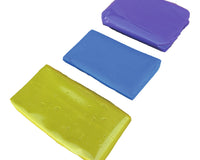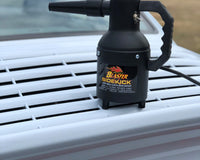In the world of automotive aesthetics, the allure of metallic paint finishes is undeniable. The captivating shimmer and depth they lend to vehicles are an embodiment of sophistication and style. However, while metallic paint offers a striking appearance, it demands vigilant care and attention to preserve its luster and guard against the detrimental effects of oxidation.
Understanding the Enigmatic Metallic Paint
The mesmerizing beauty of metallic paint lies in its unique composition. Comprised of metallic flakes or pigments blended into the base paint, it creates a distinct, reflective finish that sets it apart from conventional paint types. This specialized formulation grants vehicles a depth and sheen that catch the light, unveiling a stunning and vibrant appearance on the automotive canvas.
The essence of metallic paint lies in its ability to transform a vehicle's aesthetic presence under various lighting conditions. When sunlight or artificial light kisses its surface, the metallic particles create a play of light, unveiling a captivating dance of reflections that accentuate the vehicle's contours and lines.
The Peril of Oxidation: A Metallic Paint's Nemesis
However, amidst this beauty lies a constant threat—oxidation. The elements are fierce adversaries, with UV exposure, environmental pollutants, and moisture conspiring to wreak havoc on the delicate metallic finish. Oxidation, presenting as a dull, lackluster appearance, diminishes the once-brilliant shine, rendering the vehicle's paintwork lackluster and lifeless.
Improper cleaning methods and neglect also play pivotal roles in hastening the oxidation process. Harsh chemicals, abrasive cleaning tools, and even simple neglect can cause scratches, swirls, and premature deterioration of the metallic paint, opening doors for oxidation to take hold.
Understanding Metallic Paint's Vulnerability to Oxidation
Environmental Factors Contributing to Oxidation
Oxidation of metallic paint is often catalyzed by the elements. Ultraviolet (UV) rays, pollutants, and moisture act as adversaries, initiating a gradual assault on the metallic finish. UV rays penetrate the paint's protective layer, triggering a chemical reaction that leads to color fading and surface degradation. Pollutants in the atmosphere, such as industrial fallout, road debris, and airborne contaminants, settle on the vehicle's surface, further compromising the paint's integrity. Additionally, moisture, especially in humid climates, exacerbates the oxidation process by seeping into microscopic imperfections, hastening the breakdown of the paint's protective layers.
Impact of Improper Cleaning Techniques
Negligent or improper cleaning practices can inadvertently accelerate the onset of oxidation. Using harsh cleaning agents or abrasive tools during washing sessions can inflict micro-abrasions or scratches on the paint's surface, creating vulnerable entry points for oxidation. The use of incorrect washing methods, such as circular motions or using dirty sponges, can lead to swirl marks and diminish the paint's luster, rendering it more susceptible to oxidation. Neglecting regular cleaning and maintenance further compounds the risk, as accumulated dirt and grime act as catalysts for paint deterioration.
Preventive Measures Against Metallic Paint Oxidation
Adopting Proper Washing Techniques
Preserving the brilliance of metallic paint starts with adopting gentle and meticulous washing practices. Utilizing pH-neutral car shampoos and employing the two-bucket wash method are fundamental to preventing scratches and swirls that can weaken the paint's resilience against oxidation. Opting for high-quality microfiber wash mitts or soft brushes minimizes friction and reduces the risk of surface damage, preserving the paint's integrity.
Shielding with Protective Coatings
Applying protective coatings or sealants is pivotal in fortifying the metallic finish against the onslaught of oxidation. Products like wax, ceramic coatings, or polymer sealants form an invisible shield, shielding the paint from UV rays, environmental contaminants, and moisture. These coatings create a hydrophobic barrier that repels water and prevents pollutants from adhering to the surface, prolonging the paint's brilliance and inhibiting oxidation.
Regular Maintenance and Detailing
Regular maintenance and detailing sessions play a crucial role in combating oxidation. Periodic inspections allow for the early detection of potential issues, such as scratches, chips, or fading, enabling timely interventions. Professional detailing sessions involving paint decontamination, polishing, and application of specialized protective coatings serve as a proactive shield against oxidation. These meticulous procedures remove embedded contaminants and rejuvenate the paint's gloss, enhancing its resilience against environmental threats.

Avoiding Prolonged Exposure to Harsh Elements
Limiting the vehicle's exposure to harsh elements is an effective preventive measure. Parking in shaded areas or garages shields the paint from prolonged exposure to direct sunlight, minimizing the impact of UV rays. Furthermore, avoiding parking under trees that exude sap or near construction sites helps prevent unwanted debris or contaminants from settling on the surface, reducing the risk of oxidation.
Consistent Monitoring and Touch-Ups
Consistent monitoring and swift touch-ups are paramount in preserving metallic paint. Promptly addressing minor imperfections, such as chips or scratches, with touch-up paint prevents oxidation by preventing the exposure of bare metal to the elements. Additionally, clear coat-safe paint correction techniques, like spot polishing, can rectify minor blemishes, preserving the paint's integrity and preventing oxidation from spreading.
Professional Application of Protective Films
For heightened protection, consider professional application of paint protection films (PPF) or clear bras. These transparent films act as a sacrificial barrier, shielding the paint from environmental damage. The durable, self-healing nature of PPF offers long-term protection against scratches, rock chips, and oxidation, safeguarding the paint's brilliance while allowing its inherent shine to radiate through.
Seasonal Maintenance and Inspection
As seasons change, adapt your maintenance routine to suit varying environmental conditions. Prior to winter, perform a thorough cleaning and application of protective coatings to shield the paint from harsh weather. Similarly, post-winter, conduct a comprehensive cleaning session to eliminate salt, road grime, and contaminants that may have accumulated during the season, reducing the risk of prolonged exposure to corrosive elements.
Care for Car Metallic Paint - Conclusion
In the meticulous quest to preserve the allure of metallic paint, a proactive approach coupled with comprehensive protective measures emerges as the cornerstone. The vulnerability of metallic finishes to oxidation, catalyzed by environmental elements and negligent cleaning practices, necessitates a strategic defense plan. By understanding the contributing factors and implementing preventive measures, one can safeguard the paint's brilliance and longevity.
The detrimental effects of environmental elements, such as UV rays, pollutants, and moisture, pose a significant threat to the integrity of metallic paint. However, adopting proper washing techniques, including pH-neutral shampoos and gentle tools, fortifies the paint against scratches and surface degradation. Furthermore, the application of protective coatings, sealants, and professional detailing sessions forms an impenetrable shield, warding off the adversities of oxidation.
Consistent vigilance through regular inspections, swift touch-ups, and the use of protective films contribute to the holistic defense against oxidation. Moreover, strategic adjustments aligned with seasonal variations and vigilant avoidance of prolonged exposure to harsh elements add layers of protection, preserving the paint's radiant shine.
Ultimately, by integrating these meticulous measures into routine maintenance and adopting a proactive stance, one can effectively mitigate the risk of oxidation and ensure the enduring brilliance of metallic paint. This commitment to protective care not only enhances the aesthetic appeal but also prolongs the lifespan of the vehicle's stunning finish.




